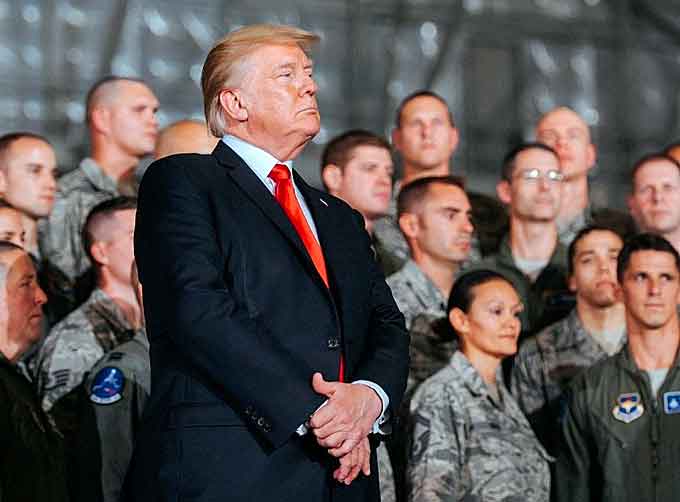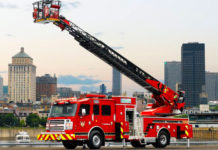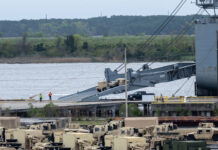
By Guy Eastman, senior analyst, Jane’s by IHS Markit
President Donald Trump signed the US FY19 National Defense Authorization Act (NDAA) on Monday, 13 August during an official visit to Fort Drum in New York state.
This is the earliest passage of the DoD “policy bill” and signing of the NDAA into public law in decades.
The NDAA was signed into law 48 days prior to the start of FY19 on 1 October 2018 – in regular order – an event that does not occur frequently.
The Act authorizes USD639.1 billion for the Pentagon’s base budget (inclusive of the Dept. of Energy national defense line items) and USD69.0 billion for the Overseas Contingency Operations (OCO) accounts.
This sums to USD708.1 billion, prior to adding Office of Management and Budget (OMB) estimates for scoring adjustments, USD8.0 billion for base national defense discretionary programs not in Armed Services Committee jurisdiction, and USD9.5 billion for national defense mandatory funds.
The total DoD 050 budget authority (discretionary plus mandatory) is USD725.5 billion for FY19, an increase of 3.28 percent over the amount enacted for FY18.
(President Trump is signing a defense spending bill Monday as his first public event after his working vacation in Bedminster, New Jersey. Mr. Trump is expected to speak at the signing of H.R. 515, the “John S. McCain National Defense Authorization Act for Fiscal Year 2019,” at Fort Drum Army Base in New York. Courtesy of CBS News and YouTube. Posted on Aug 13, 2018.)
The following provides a top-level comparison between the FY19 NDAA and FY18 enacted appropriations (FY18 Omnibus Appropriations of 23 March 2018) and is inclusive of both base and OCO budgets:
- Military Construction (MILCON) increased by USD1.8 billion to USD9.4 billion (+ 23.31%)
- MilPers accounts increased by USD14.0 billion to USD151.7 billion (+ 10.19%)
- RDT&E increased by USD3.7 billion to USD92.95 billion (+ 4.16%)
- Procurement increased by USD0.9 billion to USD145.2 billion (+ 0.62%)
- Investment (Procurement + RDT&E) increased by USD4.6 billion to USD238.1 billion (+ 1.97%)
- The four largest accounts are:
- Air Force RDT&E at USD41.0 billion
- Air Force Procurement at USD24.4 billion
- Navy Shipbuilding & Conversion at USD24.1 billion (continuing to grow)
- Defense-Wide RDT&E at USD22.9 billion
Highlights by military service are as follows:
US Army
- Army missile procurement increased 28.8% to USD5.0 billion
- Army aircraft procurement decreased by 24.7% to USD4.5 billion
- Army RDT&E decreased by 5.5% to USD10.3 billion
- Funding is authorized as follows in the NDAA:
- 10,851 Guided Multiple Launch Rocket System (GMLRS)
- 1,046 Joint Air-to-Ground (JAGM) missiles
- 240 PAC-3 Missile Segment Enhancement (MSE) missiles
- 55 UH-60 Black Hawk M Model and 18 Black Hawk A and L Model helicopters
- 48 AH-64 Apache Block IIIA (Remanufacture) and 18 Block IIIB (New Build) helicopters
- 6 MQ-1 Gray Eagle UAVs
- 135 M1A1 Main Battle Tank (MBT) upgrades
- 3,390 Joint Light Tactical Vehicles (JLTV)
- Six major vehicle acquisitions are underway and funded
US Navy & US Marine Corps
- Navy & Marine Corps procurement rose by 2.6% on the strength of Marine Corps procurement rising 41.8% to USD2.8 billion
- Navy Other procurement rose 16.1% to USD9.5 billion and ammunition rose 19.8% to USD1.2 billion
- Funding is authorized as follows in the NDAA:
- Arleigh Burke DDG production continues at 3 ships in FY19
- Virginia-class SSN submarine production continues at 2 boats in FY19
- 3 Littoral Combat Ships (LCS) authorized vice 1 requested by Navy
- Plus 1 CVN, 1 Expeditionary Sea Base, 2 Fleet Oilers, 8 Ship-to-Shore Connectors and 1 Salvage ship
- 20 USMC F-35B STOVL JSF aircraft
- 8 USMC CH-53K King Stallion heavy-lift helicopter
- 9 USN F-35C CV JSF aircraft
- 24 F/A-18E/F Super Hornet aircraft
- 251 AIM-9X and 141 AIM-120 AMRAAM AAW missiles and 750 Small Diameter Bomb II
- 125 SM-6 Standard missiles and 48 Harpoon missile mods (for maximum production capacity)
- 30 USMC Amphibious Combat Vehicle 1.1
- Acceleration of Directed Energy, Railgun, Undersea Systems and Artificial Intelligence (AI) research
US Air Force
- The largest percent increase in Air Force was ammunition at 36.6% at USD3.0 billion
- Air Force missile procurement was solid at 16.8% increase to USD3.1 billion
- However, Air Force Space procurement decreased by 28.9% to USD2.5 billion
- Air Force RDT&E showed a solid percent increase of 9.1% to USD41.0 billion
- Funding is authorized as follows in the NDAA:
- 48 F-35A CTOL JSF aircraft
- 15 KC-46A Pegasus Aerial Refueler aircraft
- Continued RDT&E funding for B-21 Raider Long-Range Strike Bomber
- 10 HH-60W Combat Rescue Helicopters and 31 MQ-9 Reaper UAVs
- 9 C-130J aircraft variants and modifications including 88 8-blade propeller and engine upgrade kits
- 5 Evolved Expendable Launch Vehicles (Space) and Evolved SBIRS sensor development research
- 360 Joint Air-to-Surface Standoff Missiles (JASSM) and 35,990 Joint Direct Attack Munition (JDAM)
- 256 AIM-9X and 222 AIM-120 AMRAAM AAW missiles and 7,336 Small Diameter Bomb I & II
- RDT&E funds for Hypersonics, Directed Energy, Quantum Computing and AI research
US Defense-Wide
- Procurement Defense-Wide rose 23.3% to USD7.3 billion
- RDT&E increased by USD0.5 billion to USD22.9 billion
- Funding is authorized as follows in the NDAA:
- 14 Ground-based Midcourse Defense (GMD) interceptors (GBIs)
- 43 Aegis Ballistic Missile Defense (BMD) SM-3 missiles
- 28 shipsets of Aegis BMD Hardware and Software
- 82 Terminal High Altitude Air Defense (THAAD) missiles
- Missile Defense Agency (MDA) funding authorized at USD9.9 billion
- Various aircraft, modifications and weapons for Special Operations Command (SOCOM)
- USD225 million for National Guard and Reserve Equipment (NG&RE)
- Increased RDT&E funding for Hypersonic Defense (MDA and OSD) and Directed Energy
- Increased RDT&E funding for Prompt Global Strike capability
- 2.6% basic pay raise for the armed forces















